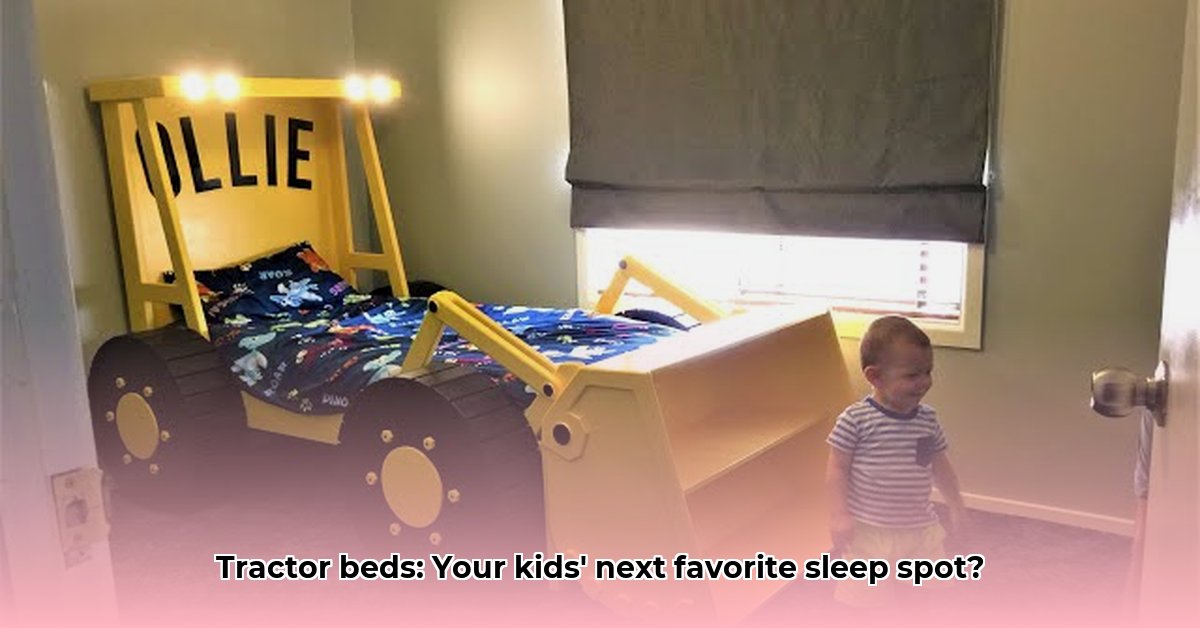
Finding the ideal tractor-themed bed for your little farmer can be an exciting adventure! This comprehensive guide will help you navigate the options, ensuring you choose a bed that's safe, durable, and perfectly complements your child's room and your budget. We'll cover everything from types and materials to customization and safety, guiding you towards the perfect purchase. For more toddler tractor bed options, check out this helpful resource: toddler tractor beds.
Children's Tractor Beds: Types and Sizes
The market offers a diverse range of tractor beds, catering to children of all ages. Choosing the right size is crucial for both comfort and safety.
Toddler Tractor Beds
These compact beds are ideal for toddlers, featuring lower sides to prevent falls and offering a cozy space for your little one's first independent sleep experiences. They're designed with safety and comfort as top priorities.
Twin-Size Tractor Beds
As your child grows, a twin-size tractor bed provides ample space for sleeping and playing. This popular choice balances size and affordability, offering a comfortable and spacious sleeping area.
Full-Size Tractor Beds
For older children needing more room, a full-size tractor bed provides a generous sleeping area. It might even accommodate a sibling or two occasionally (though we don't recommend regular shared sleeping!).
Bunk Beds & Loft Beds
Space-saving solutions for multiple children or smaller rooms, bunk beds and loft beds offer a fun, tractor-themed sleeping arrangement. Always prioritize safety features like sturdy guardrails when choosing a bunk bed.
Materials and Construction: Quality and Durability
The materials used significantly impact a bed's durability, safety, and price. Let's examine the common options:
Solid Wood
Solid wood offers exceptional durability and timeless appeal. These beds are sturdy and long-lasting, but tend to be more expensive and heavier than other options. Regular maintenance might be needed to preserve their beauty.
Metal (Steel)
Metal frames provide sturdiness and are easy to clean. They are often more affordable than solid wood, but might not offer the same visual charm and can be prone to dents and scratches.
Fiberboard (MDF)
Fiberboard is a budget-friendly option but less durable than wood or metal. Lighter to move, it's more susceptible to damage and might not withstand the enthusiasm of a young child over time.
Regardless of material, always check for safety certifications and ensure the bed is free from harmful chemicals. Prioritizing safety is paramount. Have you considered the long-term durability of different materials? Solid wood often provides better value over time.
Price Range and Value: Budget Considerations
Prices vary significantly, ranging from a few hundred dollars for simple toddler beds to over a thousand for elaborate bunk beds. The price reflects factors like size, materials, level of detail, and additional features. Remember: comparing value is key. A slightly more expensive, high-quality bed might prove a better long-term investment than a cheaper alternative needing replacement sooner.
Customization Options: A Personalized Touch
Many manufacturers offer customization options, allowing you to personalize your child's bed. Options might include color selection, adding decals, or choosing unique design elements. This personal touch enhances the bed's appeal by reflecting your child’s personality.
Assembly and Installation: DIY or Professional Help?
Some beds arrive fully assembled, while others require assembly. Carefully review the instructions beforehand. If you're not comfortable with DIY, hiring a professional ensures correct and safe assembly, preventing potential frustration and safety hazards.
Safety Considerations: Ensuring a Secure Sleep Space
Safety is paramount. Verify that the bed meets or exceeds relevant safety standards (such as those set by the CPSC 1). Pay close attention to the stability of bunk beds, ensuring sturdy guardrails. Look for certifications confirming the use of non-toxic materials.
Buyer's Guide: Making the Right Choice
This checklist summarizes key factors to consider when choosing a children's tractor bed:
Child's Age and Size: Determine the appropriate bed size based on your child's current and future needs.
Budget: Establish a realistic budget to guide your search.
Materials: Prioritize durability and safety when selecting materials.
Customization: Decide if personalization is important to you.
Assembly: Assess your skills and comfort level with DIY projects.
Safety Certifications: Verify compliance with safety standards and non-toxic materials.
Choosing the perfect tractor bed involves balancing style, functionality, safety, and budget. By carefully considering these factors, you'll create a special and safe haven for your child's restful sleep and imaginative play!